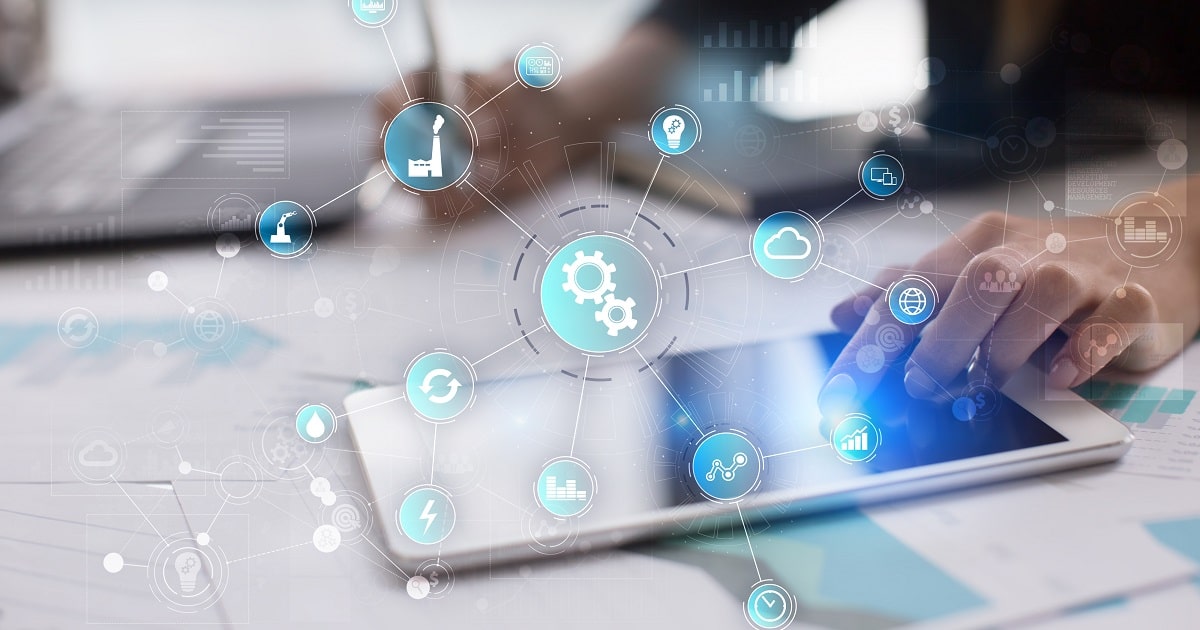
Platforms
Zyter | March 01, 2022
Zyter, Inc., a leading digital health and IoT-enablement platform, announced today that it has collaborated with Qualcomm Technologies, Inc. to support the demonstration of 5G private networks by providing network management services, a user interface/dashboard, and three initial production-ready applications that include autonomous mobile robots (AMRs), LiDAR-based analytics and AI-based cameras.
5G private networks offer significant advantages over today’s public 5G and Wi-Fi networks. To fully support digital transformation efforts, modern businesses and organizations need a higher-bandwidth, lower-latency network that can potentially support thousands of devices and data intensive applications. Advanced network management capabilities, such as allocating bandwidth to different devices or customizing security protocols are also necessary. Current Wi-Fi and 5G public networks offer limited flexibility in these areas. Qualcomm Technologies, Zyter and other ecosystem members are solving these challenges through the demonstration of 5G private networks powered by Qualcomm® FSM 5G RAN Platforms.
In addition to providing network management and a consolidated dashboard to display application and device data, Zyter is also making three production-ready applications available that include:
Autonomous Mobile Robots (AMRs)– Equipped with sensors and cameras, AMRs use AI and machine learning to autonomously move goods inside a defined space such as a factory or warehouse.
LiDAR-Based Analytics– Light Detection and Ranging (LiDAR) cameras can be used to detect the movement of people and goods in a defined space, which is rendered on a 3D map viewed on Zyter's dashboard.
AI-Based Cameras–This application supports 4K video streams originating from eight cameras provided by Qualcomm Technologies’ device ecosystem members as well as data analysis.
“Applications like LiDAR-based analytics require high bandwidth, low latency networks that can potentially support thousands of devices, render images in 3D, or enable autonomous mobile robots to react in milliseconds. The combination of Qualcomm Technologies’ platforms for 5G private networks with Zyter’s leading-edge applications offer a world of new possibilities for organizations that want more performance, ownership and control.”
Sanjay Govil, founder and CEO of Zyter, Inc.
About Zyter, Inc.
Zyter delivers a wide range of Internet of Things (IoT) solutions spanning buildings, stadiums, campuses, and even cities. The Zyter SmartSpaces platform supports solutions for multiple markets including healthcare, education, logistics, retail, travel, and construction. By integrating and consolidating data from IoT devices and applications, organizations can gain new insights to improve efficiencies while providing end-users with an engaging digital experience. In 2021, Zyter won more than 37 global awards for its IoT products including Best Technology and Company Innovation of the Year. Founded in 2017, the privately-held company is based in Rockville, Md.
Read More

Enterprise Iot
T-Mobile | February 22, 2022
T-Mobile US and Deutsche Telekom AG launched T-IoT, a comprehensive enterprise solution for global IoT connectivity, platform management and support. With T-IoT, enterprises have one global team and one global solution to manage all their connections across borders! And it will be available across 188 destinations, on 383 networks worldwide.
“The Un-carrier rewrote the rules of wireless. Now, as America’s 5G leader, with the fastest, largest, and most reliable 5G network, we’re writing the rules of the 5G era, and we’re doing it in favor of customers and businesses,” said Mike Katz, President, T-Mobile Business Group. “With T-IoT and our award-winning networks, we’re poised to help businesses realize the true potential of IoT by completely disrupting the status quo of how IoT is purchased and managed.”
Unleashing the Power of IoT
Despite all the excitement around IoT’s ability to make the connected world a reality, unlock valuable business insights, improve customer experience, cut operational costs, and boost efficiency—many enterprises haven’t fully captured value at scale from IoT. Why is this still happening in 2022? A major reason is that Carriers make enterprises jump through hoops to manage IoT connectivity globally. To deploy multinational IoT connections, enterprises have to cobble together a patchwork of operator agreements—all with different contracts, service level agreements, management interfaces, and customer support.
And 5G promises to take IoT to the next level, with cellular 5G IoT connections projected to make up 57 percent of all worldwide cellular IoT connections by 20251. With 5G’s ability to support low-latency, massive data use, and connect up to 100x more devices than 4G—enterprises have a HUGE opportunity to embrace new use cases and actionable data that will make the longstanding vision of 5G IoT a reality.
But the gap between the promise of 5G IoT and reality will be wide if managing all that connectivity and data remains unnecessarily complex.
Here’s why: Imagine millions of tracked assets moving across the globe. To stay connected to those assets, enterprises have to negotiate numerous contracts with multiple network operators in different countries and regions, each with its own contract, and service level agreements. Then, to view and manage those devices, they navigate a multitude of platforms from various operators. And for every issue that arises, you can bet there are different customer care and support teams.
There’s also little flexibility in how enterprises pay for IoT. Each Carrier has its own payment model which makes it hard for businesses to effectively scale IoT across the globe. And with 5G, scaling will be even more important to deliver valuable use cases, analytics, data insight, and return-on-investment.
Enter T-IoT—a solution optimized for enterprises with global IoT needs
Today we say “goodbye” to that complex and rigid system because T-Mobile and Deutsche Telekom are coming together to disrupt the status quo with T-IoT. This one-of-a-kind global offering exemplifies two words rarely associated with IoT simple and flexible.
T-IoT will deliver:
Worldwide network connectivity spanning the full range of technologies to support nearly every possible IoT scenario today, and tomorrow—including NB-IoT, LTE-M, LTE, and 5G.
A single pane of glass to easily view, and eventually manage global IoT connections across several platforms, including T-Mobile Control Center and Deutsche Telekom M2M Service Portal, with T-IoT Hub.
A simplified procurement process that includes streamlined contract and billing, consistent global service level agreements, and customer support.
Flexible pricing with a pay-per-data model OR a choice of three flat-rate unlimited connectivity packages (T-IoT Unlimited Base, T-IoT Unlimited Premium, and T-IoT Unlimited Pro) across the U.S. and Europe, as well as value added services to serve connectivity needs for the lifetime of the device.
"One provider. One solution. That's 'making it simple' taken at its word. Many industries, such as healthcare or automotive, depend on international supply chains. And their customers today rely on receiving service and assistance anywhere in the world. We're able to do that with this transatlantic collaboration, with our networks, for the best customer experience worldwide."
Hagen Rickmann, Managing Director Business Customers, Telekom Deutschland
“With millions of connected Mercedes-Benz vehicles in nearly every corner of the world today, and up to 20 million connected cars in our fleet by 2025, we need be able to rely on telecommunications partners like T-IoT, that offer us global network coverage and an ecosystem for IoT leadership,” said Ola Källenius, Chairman of the Board of Management, Mercedes-Benz Group AG. “Real-time, high-bandwidth data transmission is key to digital innovation. 5G technology in IoT scenarios will allow our vehicles to communicate with the speed and reliability needed to offer our customers greater efficiency through improved routing and improved safety.”
BIOTRONIK, a leading global medical device company based In Berlin, also relies on seamless connectivity. With their innovative, first-in-class Home Monitoring solution, many BIOTRONIK medical devices are connected devices, which help to significantly increase the quality of lives of millions each year. Patients can travel without worry as BIOTRONIK works with around 5,000 hospitals worldwide, which provide care in the event of an emergency at all times.
"We combine digital medical solutions and state-of-the-art communication technology. With Home Monitoring, the patient’s vital data is digitally available to the medical team and are constantly analyzed. If threshold values are exceeded, the medical team can react immediately," says Volker Lang, Senior Vice President Research and Development. "This only works with an absolutely reliable network that transmits the data reliably at all times. We are active in over 100 countries. The T-IoT infrastructure is indispensable for us.”
About T-Mobile
T-Mobile US, Inc. is America’s supercharged Un-carrier, delivering an advanced 4G LTE and transformative nationwide 5G network that will offer reliable connectivity for all. T-Mobile’s customers benefit from its unmatched combination of value and quality, unwavering obsession with offering them the best possible service experience and undisputable drive for disruption that creates competition and innovation in wireless and beyond. Based in Bellevue, Wash., T-Mobile provides services through its subsidiaries and operates its flagship brands, T-Mobile, Metro by T-Mobile and Sprint.
Read More

Platforms
CCww | February 19, 2022
Communications Consultants Worldwide Limited (CCww), innovator of 3GPP® technologies and Lekha Wireless Solutions Pvt Ltd. (Lekha), a technology solutions company with expertise in communications and embedded systems, announce today the creation of a test bench system for NTN (Non-Terrestrial Networks) IoT. This includes a UE protocol-stack + PHY combination and an eNodeB with integrated SDR.
Global IoT solutions require global coverage, made possible through satellites 'filling-in' where ground-based cellular IoT isn't available. 3GPP® Release 17 will specify narrow-band protocols for Low-Earth Orbit (LEO) and Geostationary (GEO) satellite communications. CCww and Lekha are re-purposing their joint Release 14 NB-IoT UE design, and Lekha's eNB design; both systems will handle the higher levels of Doppler, noise and delay encountered in satellite communications. The NTN versions of UE and eNB, with a system manager and channel emulator, will be integrated to produce a software test bench, to allow testing of NTN IoT without major up-front investment.
The development is partly funded by the European Space Agency (ESA) within its Advanced Research in Telecommunications Systems (ARTES) Competitiveness & Growth programme.
The standard NB-IoT UE and eNB software stacks execute on Xilinx Zedboard and TI SoC respectively, and are available to license for development and test; services are offered for product development, integration and live test.
"Having created a cellular NB-IoT UE with Lekha, it's natural to collaborate to pioneer NTN IoT; whilst our designs will support the approved Release 17 and later releases, we will create an early system for lab-testing."
CCww's CEO, Richard Carter
Amarnadha Reddy, Founder Director of Lekha, added, "our experience in SDR enables us to characterise the propagation characteristics unique to satellite operation, and create the most efficient PHY for NTN operation."
About CCww
CCww has developed, licensed and supported embedded 3GPP® protocol stack software to global mobile organisations since 2000; over 3 Billion devices use CCww technology. CCww licenses portable UE stacks, with integration, conformance-testing, and support services; current focus: NTN IoT. CCww is a full member of ETSI and GSMA Mobile IoT Innovators.
About Lekha
Lekha is a Technology solutions company, providing end-to-end solutions for wireless communications and embedded systems. We license software stacks for 5G, 4G and WiMAX technology and offer services to port to target SoC processor cores. We sell telecom infrastructure products that are powered by our software stacks to enable private enterprise networks. IP offerings include NB-IoT PHY; successfully integrated in commercial SoCs. NB-IoT IP is optimized for ARM, Cadence and Synopsis processor cores, and benchmarked for low power and footprint. Partnership with CCww is key to deliver an integrated, proven solution, and reduce time to the fast-growing IoT market.
Read More